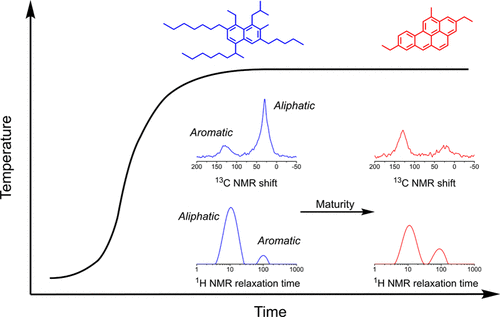当前位置:
X-MOL 学术
›
Energy Fuels
›
论文详情
Our official English website, www.x-mol.net, welcomes your feedback! (Note: you will need to create a separate account there.)
Combined High-Resolution Solid-State 1H/13C NMR Spectroscopy and 1H NMR Relaxometry for the Characterization of Kerogen Thermal Maturation
Energy & Fuels ( IF 5.3 ) Pub Date : 2020-12-29 , DOI: 10.1021/acs.energyfuels.0c02713 Francesco Panattoni 1 , Jonathan Mitchell 2 , Edmund J. Fordham 2 , Ravinath Kausik 3 , Clare P. Grey 1 , Pieter C. M. M. Magusin 1
Energy & Fuels ( IF 5.3 ) Pub Date : 2020-12-29 , DOI: 10.1021/acs.energyfuels.0c02713 Francesco Panattoni 1 , Jonathan Mitchell 2 , Edmund J. Fordham 2 , Ravinath Kausik 3 , Clare P. Grey 1 , Pieter C. M. M. Magusin 1
Affiliation

|
A key factor for the petroleum potential of source rock is the degree of chemical and physical structure evolution of its kerogen fraction through a range of maturation processes. In this study, various high-field, solid-state NMR methods have been applied to a series of kerogen isolates (type I) over a defined maturity range (vitrinite reflectance R0 from 0.98 to 1.86%). Results obtained from 13C MAS NMR show that the sp2/sp3-hybridized carbon ratio of kerogen, here defined as the aromatic/aliphatic ratio, increases with increasing maturity. 1H MAS NMR spectra contain partly overlapping aliphatic and aromatic resonances with distinct transverse relaxation behavior. In Hahn-echo experiments, the aromatic signal decays more slowly than the aliphatic signal, indicating that for these systems, transverse 1H relaxation is rather controlled by local distances between hydrogen atoms than by molecular mobility. Similar relaxation differences are also found in static (nonspinning) 1H Hahn-echo NMR experiments, here used to discriminate between phases with different proton mobilities and/or densities in the kerogen samples and, ultimately, between aromatic and aliphatic fractions. The distributions of the static transverse relaxation time (T2), extracted from the Hahn-echo decays, are characterized by a short-T2 peak (∼10 μs) and a long-T2 peak (∼100 μs). The ratio between these two peaks correlates well with the aliphatic-to-aromatic signal intensity ratios in MAS NMR spectra of the corresponding kerogen samples, suggesting that a net decrease in kerogen proton density—occurring during maturation—is also reflected by 1H NMR relaxation. For the investigated kerogen isolates, the long-T2 peak in the T2 distribution can be considered an indicator of aromatic content, which can be directly detected by measuring 1H T2 relaxation.
中文翻译:

结合的高分辨率固态1 H / 13 C NMR光谱和1 H NMR弛豫法用于表征干酪根的热成熟度
烃源岩具有石油潜力的关键因素是其在一系列成熟过程中干酪根组分的化学和物理结构演化程度。在这项研究中,已将各种高场固态NMR方法应用于定义的成熟度范围(镜质体反射率R 0为0.98至1.86%)上的一系列干酪根分离物(I型)。从13 C MAS NMR获得的结果表明,干酪根的sp 2 / sp 3杂化碳比(此处定义为芳香族/脂肪族比)随着成熟度的增加而增加。1个H MAS NMR光谱包含部分重叠的脂族和芳族共振,具有明显的横向弛豫行为。在Hahn-echo实验中,芳族信号的衰减比脂族信号更慢,这表明对于这些系统,横向1 H弛豫由氢原子之间的局部距离而非分子迁移率控制。在静态(非旋转)1 H Hahn-echo NMR实验中也发现了类似的弛豫差异,此处用于区分干酪根样品中质子迁移率和/或密度不同的相,以及最终区分芳香族和脂肪族部分。静态横向弛豫时间(T 2)的分布从Hahn-echo衰减中提取的)的特征是短T 2峰(〜10μs)和长T 2峰(〜100μs)。这两个峰之间的比值与相应干酪根样品的MAS NMR光谱中的脂族与芳族信号强度比具有很好的相关性,这表明1 H NMR弛豫也反映出干酪根质子密度的净下降(在成熟过程中发生)。。对于所研究的干酪根分离物,可以将T 2分布中的长T 2峰视为芳香含量的指标,可以通过测量1 H T 2弛豫来直接检测到。
更新日期:2021-01-21
中文翻译:

结合的高分辨率固态1 H / 13 C NMR光谱和1 H NMR弛豫法用于表征干酪根的热成熟度
烃源岩具有石油潜力的关键因素是其在一系列成熟过程中干酪根组分的化学和物理结构演化程度。在这项研究中,已将各种高场固态NMR方法应用于定义的成熟度范围(镜质体反射率R 0为0.98至1.86%)上的一系列干酪根分离物(I型)。从13 C MAS NMR获得的结果表明,干酪根的sp 2 / sp 3杂化碳比(此处定义为芳香族/脂肪族比)随着成熟度的增加而增加。1个H MAS NMR光谱包含部分重叠的脂族和芳族共振,具有明显的横向弛豫行为。在Hahn-echo实验中,芳族信号的衰减比脂族信号更慢,这表明对于这些系统,横向1 H弛豫由氢原子之间的局部距离而非分子迁移率控制。在静态(非旋转)1 H Hahn-echo NMR实验中也发现了类似的弛豫差异,此处用于区分干酪根样品中质子迁移率和/或密度不同的相,以及最终区分芳香族和脂肪族部分。静态横向弛豫时间(T 2)的分布从Hahn-echo衰减中提取的)的特征是短T 2峰(〜10μs)和长T 2峰(〜100μs)。这两个峰之间的比值与相应干酪根样品的MAS NMR光谱中的脂族与芳族信号强度比具有很好的相关性,这表明1 H NMR弛豫也反映出干酪根质子密度的净下降(在成熟过程中发生)。。对于所研究的干酪根分离物,可以将T 2分布中的长T 2峰视为芳香含量的指标,可以通过测量1 H T 2弛豫来直接检测到。



























 京公网安备 11010802027423号
京公网安备 11010802027423号